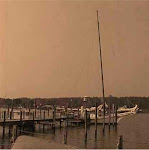

July 2010
This is what the shipwrights found beneath the flooring of the aft cabin -- photos by Jim Laws, 1st Carpenter, Restoration of the Dee of St. Mary's.
This is the new keel -- completed by Francis Goddard, Benjamin Goddard & James Laws.


The keel was the central concern regarding the 30-year-old skipjack. Its successful repair has passed U.S. Coast Guard muster. While a tremendous amount of work remains -- in the hull alone bulkheads must be replaced and pieces of braces and structural ribs made clean and whole -- the successful replacement of the keel is a huge accomplishment. This was the first and primary goal of the Maryland Heritage Areas Authority grant as well as the supporting grant from Preservation Maryland.
To orient the keel within the hull and in conjunction with the decking the standard 6' ladder pictured in most of the following photos has not moved:
 The forward legs of the ladder rest on the new cap that runs from the aft bulkhead through the midsection of the hull. The midsection is where the diesel motor will return to a reconstructed cradle.
The forward legs of the ladder rest on the new cap that runs from the aft bulkhead through the midsection of the hull. The midsection is where the diesel motor will return to a reconstructed cradle. Stabilizing members are replaced if necessary. Except for a few staves in the bow the hull is intact.
Stabilizing members are replaced if necessary. Except for a few staves in the bow the hull is intact.Rot, say the shipwrights, from the keel to the deck comes from fresh water gathering and seeping into the wood. Salt water acts as a wood preservative.
 The gaping hole in the foreground is where the fore cabin was removed to replace rotten decking around it and rot in the cabin itself.
The gaping hole in the foreground is where the fore cabin was removed to replace rotten decking around it and rot in the cabin itself. Facing forward from the wheel housing the ladder is obscured by the aft cabin , but the flashlight and broom are visible in both deck shots.
Facing forward from the wheel housing the ladder is obscured by the aft cabin , but the flashlight and broom are visible in both deck shots. The wheelhouse aft of the aft cabin.
The wheelhouse aft of the aft cabin.The Chesapeake Bay Field Lab is seeking venues to apply for additional grants and for donations to extend the restoration to the decking and exterior hull. They can be located at www.thebaylab.org
Thanks for reading.

No comments:
Post a Comment